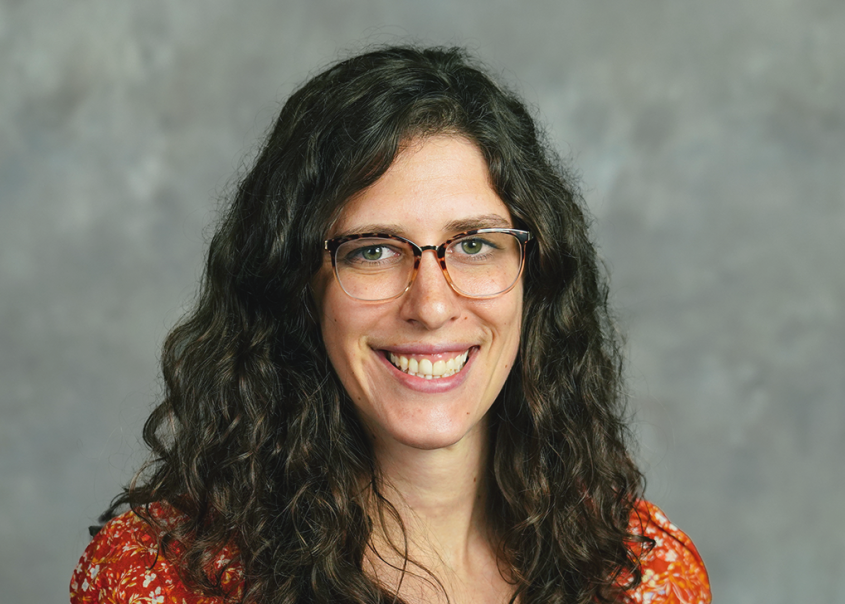New faculty profile: Dr. Corinna Noel
The Cornell University College of Veterinary Medicine (CVM) has recently welcomed many new faculty members to our academic departments, each one bringing a unique set of skills and experience that enriches our college every day. In this Q&A series, you'll get to know their interests, expertise and more.
Dr. Corinna Noel, assistant professor of practice in the Department of Public and Ecosystem Health
Q: What has been your academic/career path leading to Cornell?
As an undergraduate mathematics major, I was always looking for a way to connect my quantitative skills to the field of human health. After a summer research experience at Cornell, I decided to come to Cornell for my Ph.D. and study the taste system and its connection to obesity (using my statistics skills to analyze all the data). While at Cornell, I discovered the field of epidemiology, which was a perfect combination for my quantitative background and desire to understand and improve population health. The rest is history! I completed a postdoc in epidemiology at the Brown University School of Public Health, and then returned to the area to teach and work as an epidemiologist in Cayuga County. I am excited to be joining the Department of Public and Ecosystem Health as an assistant professor of practice, and apply my interdisciplinary training and experience to mentor and teach students and continue to engage with community partners on local public health initiatives.
Q: What drew you to CVM?
The impact-oriented community. It is inspiring to be surrounded by colleagues who are making a difference, and passionate about what they do.
Q: What is your academic area of expertise?
I am an epidemiologist, with a passion for using data and science to help inform targeted public health action. I have a special interest in understanding behavioral and environmental factors that influence population health as well as identifying high need populations and gaps in services on a local level. I work with a variety of community partners, where I aim to enhance data-driven decision-making capacity and develop methods to disseminate data effectively. Recent work has focused on improving opioid overdose surveillance systems and applying, implementing, and evaluating evidence-based initiatives in a rural local county. In my multidisciplinary role, I have been lucky enough to gain experience in a many different areas, including epidemiological methods and statistics, geospatial analysis, disease prevention and surveillance, as well as behavioral and environmental determinants of health.
Q: What drew you into this area? Any specific experiences, mentors or influences that helped guide you?
I have a wonderful mentor, Dr. Pat Cassano in the Division of Nutrition at Cornell, who I met during graduate school. She introduced me to the field of epidemiology, which started me on my path to where I am today. I am very thankful for her ongoing support, as well as all the experiences I have had and people I have met along the way.
Q: What past professional work are you most proud of and why?
I am proud of the opioid overdose prevention work I have done with my colleagues locally during the COVID-19 pandemic. After observing a concerning spike in overdose deaths following the COVID-19 shutdowns in early 2020, we designed and implemented a multi-faceted Narcan training and distribution initiative to ensure equitable access to the life-saving medication throughout a rural county. We were able to successfully train and distribute Narcan to an average of 94 people per month in the first two years, representing a nearly 720% increase of Naloxone distribution on average per year since this initiative was implemented. I led the monitoring and evaluation efforts, which showed that we were able to reach high-need and diverse populations throughout the county. We also observed an increase in bystander administration of Narcan at scenes of overdoses, estimating that 91 lives were potentially saved through this initiative.
Q: What impacts or applications do you hope to see your work have on the world, human/animal/planetary health?
In working to improve public health outcomes, I’d like to convince naysayers that data and statistics are a vital part of the decision-making process and utilize methods in GIS and data science to effectively communicate it. I’d like to focus on enhancing analytic efforts in smaller, rural counties where data capacity is often limited.
Q: What questions are you looking to answer next/areas you plan to explore?
I am developing and planning to evaluate a public-facing, interactive, near real-time overdose surveillance data dashboard to assist in data-driven decision making in a rural community. Action-oriented dashboards have been suggested to provide a unique opportunity to reproducibly disseminate digestible data, identify gaps in service and areas of high need, and also provide links to health programs and resources. I’d like to understand how this kind of resource is utilized by stakeholders and the public, and if it is utilized to inform targeted public health action on a local level.
Q: What’s something most people don’t know about you?
I lived in Germany for a year when I was younger. I used to be fluent in German, but now, have sadly lost most of my language skills (or comes out as a mix of German, Spanish, Italian, and English!)
Q: What’s the best part of your job?
Being able to make a difference! It is so rewarding to work in the public health field in the community that you live. While the work is not always easy, it is motivating to see progress. I also really enjoy working with and mentoring students, in an effort to solve complex, real-world problems.
Q: What’s the most challenging part?
Balancing it all! Life outside work is important too.
Q: What are the benefits of working at CVM? At Cornell?
I am always amazed at the diversity of work being done at the Cornell. Just when you think you have discovered it all, there is always something new to learn and someone new to meet.





